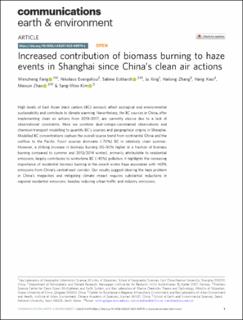| dc.contributor.author | Fang, Wenzheng | |
| dc.contributor.author | Evangeliou, Nikolaos | |
| dc.contributor.author | Eckhardt, Sabine | |
| dc.contributor.author | Xing, Ju | |
| dc.contributor.author | Zhang, Hailong | |
| dc.contributor.author | Xiao, Hang | |
| dc.contributor.author | Zhao, Meixun | |
| dc.contributor.author | Kim, Sang-Woo | |
| dc.date.accessioned | 2023-10-16T13:32:21Z | |
| dc.date.available | 2023-10-16T13:32:21Z | |
| dc.date.created | 2023-10-10T12:41:08Z | |
| dc.date.issued | 2023 | |
| dc.identifier.citation | Communications earth & environment. 2023, 4, 310. | en_US |
| dc.identifier.issn | 2662-4435 | |
| dc.identifier.uri | https://hdl.handle.net/11250/3096781 | |
| dc.description.abstract | High levels of East Asian black carbon (BC) aerosols affect ecological and environmental sustainability and contribute to climate warming. Nevertheless, the BC sources in China, after implementing clean air actions from 2013‒2017, are currently elusive due to a lack of observational constraints. Here we combine dual-isotope-constrained observations and chemical-transport modelling to quantify BC’s sources and geographical origins in Shanghai. Modelled BC concentrations capture the overall source trend from continental China and the outflow to the Pacific. Fossil sources dominate (~70%) BC in relatively clean summer. However, a striking increase in biomass burning (15‒30% higher in a fraction of biomass burning compared to summer and 2013/2014 winter), primarily attributable to residential emissions, largely contributes to wintertime BC (~45%) pollution. It highlights the increasing importance of residential biomass burning in the recent winter haze associated with >65% emissions from China’s central-east corridor. Our results suggest clearing the haze problem in China’s megacities and mitigating climate impact requires substantial reductions in regional residential emissions, besides reducing urban traffic and industry emissions. | en_US |
| dc.language.iso | eng | en_US |
| dc.rights | Navngivelse 4.0 Internasjonal | * |
| dc.rights.uri | http://creativecommons.org/licenses/by/4.0/deed.no | * |
| dc.title | Increased contribution of biomass burning to haze events in Shanghai since China’s clean air actions | en_US |
| dc.title.alternative | Increased contribution of biomass burning to haze events in Shanghai since China’s clean air actions | en_US |
| dc.type | Peer reviewed | en_US |
| dc.type | Journal article | en_US |
| dc.description.version | publishedVersion | en_US |
| dc.rights.holder | © The Author(s) 2023 | en_US |
| dc.source.volume | 4 | en_US |
| dc.source.journal | Communications Earth & Environment | en_US |
| dc.identifier.doi | 10.1038/s43247-023-00979-z | |
| dc.identifier.cristin | 2183320 | |
| dc.relation.project | Norges forskningsråd: 275407 | en_US |
| dc.relation.project | NILU: 118063 | en_US |
| dc.source.articlenumber | 310 | en_US |
| cristin.ispublished | true | |
| cristin.fulltext | original | |
| cristin.qualitycode | 1 | |

